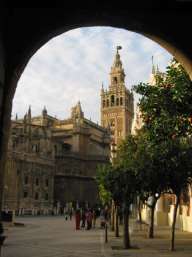
Seville Cathedral – What a beautiful piece of architecture! The Catedral de Santa Maria de la Sede located in the centre of Seville, Andalucia is the largest Gothic church in the world.
In fact it is the fourth largest Christian church found anywhere in the world. The site it covers is a vast 76 by 115 meters and the highest point, the central nave, reaches 42 meters. The main altar is also believed to be the largest in the Christian world.
 Construction of the Seville Cathedral began in 1402 and continued right through into the 16th Century. It was built on the site that previously had been occupied by a great Mosque, some of the parts of which were ‘recycled’ and included in the new building.
Construction of the Seville Cathedral began in 1402 and continued right through into the 16th Century. It was built on the site that previously had been occupied by a great Mosque, some of the parts of which were ‘recycled’ and included in the new building.
Most famously the Giralda (possibly the city’s most recognizable symbol) was a minaret, but converted into the bell tower during construction. This is one of only three remaining examples of Minarets that can be found today, the other two are held in Marrakesh and Rabat respectively. The unusual squarish shape of the Cathedral is attributed to the foundations being that of a Mosque.
Although not crowded with decoration, what is there is certainly lavish with plenty of gold used. The altarpiece is adorned by depictions of the life of Christ carved out of wood and covered in gold and were the lifetime work of a Flemish man named Pierre Dancart. Several important artefacts and crypts are held at the Cathedral including various pieces of religious jewellery and paintings including several by the artist Murillo.
The tomb of Christopher Columbus is also held there since it was transferred from its original place at the cathedral of Havana in Cuba which Columbus discovered on his first voyage in 1492. The upheavals caused by and during the Cuban revolution at the beginning of the 20th century meant the tomb was relocated to Seville.
It was built to demonstrate Seville’s affluence which was once one of the largest and important trading centres in the world. Although there are touches of influence from other parts of Europe, it seems to have a personality all of its own, and the nave is often described as ‘soaringly powerful’, and certainly ‘structurally daring’.
Although sometimes slightly overlooked, it is felt by many to be the greatest example of gothic architecture in the whole of Europe.
The Seville Cathedral is still in use today and during Corpus Christi and Immaculate Conception services altar boys with castanets dance in front of the high altar. The many thousands of visitors that head to Seville each year are rarely disappointed!

